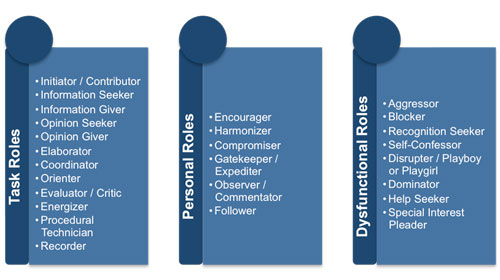Benne and Sheats' Group Roles
As a manager, you know just how complex and unpredictable teams and groups can be. Even when you have a group of highly qualified individuals with skills that are perfectly suited to the task at hand, you still might have trouble successfully reaching the goal. The problem, often, is that the personalities and roles that each person takes on might not successfully work together with the others in the group. Only when a team is comprised of a good balance of roles, along with the right skills, will it be successful.
Benne and Sheats' Group Roles are not new, but they are just as relevant now as they were when they were first published in the 1940's. There are a great number of roles that they defined, 26 in fact, and each of them is divided up into one of three categories - task roles, personal roles, and social roles. While we aren't going to go into each of the 26 roles here in this eBook, let's look at some of the more notable ones, along with the groups that they fit into.
 |
Task Roles
As the name would indicate, task roles relate to actually getting the job done. These are things that need to be completed along the path from getting a project started all the way through completion. One such role is that of the Information Seeker. This person tracks down all of the necessary information related to the project, and makes sure it is in place before getting too far along. This could mean bringing in additional people to the group that possess the necessary information, or simply doing some additional research.
Another member of the task roles group is the Elaborator. This role is important because this person generally will take the ideas of other people and expand on them until they are fully explored and considered. Sometimes, the ideas that an Elaborator works on will end up being dead ends - but other times they could turn into excellent options that the team as a whole needs to explore further.
A more outspoken member of the task roles group is the Opinion Giver. Never shy about speaking up, the Opinion Giver might rub some other people in the group the wrong way from time to time. However, this type of person is important because they may offer up ideas that no one else in the group had - or they were afraid to present. Groups are most successful when the individuals within them feel empowered to speak up and express their ideas, so an Opinion Giver can be a valuable asset.
One last vital member of the task roles group is the Energizer. No matter what kind of task or project is being worked on, there are bound to be periods of frustration or lagging motivation. The Energizer is the person that has a natural persistence and energy which can translate to the rest of the team. Staying motivated and focused on the goal is a big part of success in business, so this person can be indispensable on a group project.
Personal Roles
The interpersonal relationships within the group might have as much to do with its success or failure as any other single element. When people get along as part of a team, and respect each other as professionals, the results of a project are likely going to be much better. Unfortunately, it isn't always easy to get a group of people to work together toward a common goal - especially if that means temporarily putting aside their own personal aspirations or motivations.
The first role defined within this category is the Encourager. Much like the Energizer from the task roles category, this is a person who helps with morale and motivation. They have a positive attitude and generally get along well with everyone on the team. In the face of adversity, having at least a couple of people who naturally fill this role is a great benefit.
Along the same lines, the Compromiser is a welcome addition to a group for obvious reasons. Someone who fits in this role won't let their ego get in the way of compromising on a disagreement for the benefit of the team. Having too many Compromisers, however, could be troublesome as no one would be willing to take a stand and fight for their opinion.
Another quiet, but valuable, member of the team is the Follower. This person doesn't lead others in the group, but is happy to take direction and fill their role to the best of their ability. Many groups are undone by the fact that everyone wants to be in charge, so having a few Followers on the team is a necessary ingredient. While they may be quiet and even reserved, that doesn't mean their role on the team can't be crucial to success.
Dysfunctional Roles
A team is worse off for having any of these roles be filled by one or more of its team members. Dysfunctional roles are those that don't serve any positive purpose and only further the frustration of the group. For example, the Aggressor is a classic example of a Dysfunctional role. This person is condescending with their comments to others in the group, and is usually trying to work their way to the top by knocking others down.
The Blocker is another example of someone who can hold a team back. This person doesn't like any of the ideas that are presented by other members of the group, yet never seems to offer up anything constructive on their own. With this person in the way, it becomes more difficult for the team to achieve its ultimate goals.
These are just a few examples from each category of the group roles defined by Benne and Sheats. For a manager, it is important to understand what kind of roles exist within a group so you can figure out who is playing what role on your teams. With that knowledge in hand, you can then make decisions with the goal of optimizing performance throughout the group.
You may also be interested in:
Mintzberg's Management Roles | Lencioni's Five Dysfunctions of a Team | Birkinshaw's Four Dimensions of Management | Waldroop and Butler's Six Problem Behaviors | Cog's Ladder | Leader-Member Exchange Theory | Belbin's Team Roles | Benne and Sheats' Group Roles | Margerison-McCann Team Management Profile | The JD-R Model.



